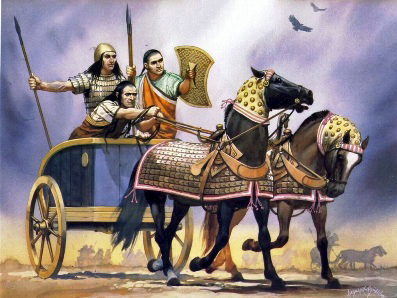| lithaz.org: home & art/culture events organizations publications |
| 5/31/2015 |
Lithuanian Language:Ancient Roots |

"Hittites" drawing by unknown artist, photo from ataccdayton.org website
|
The roots of the Lithuanian language are very ancient. They reach back at least to about 1,500 B.C. to the cultures of seminomadic livestock herders living on the vast eurasian grasslands (steppes) south of the Ural mountains. These people domesticated the horse and invented the chariot. Horses and chariots gave them a fast fighting platform which they used to their advantage in raids on their neighbors to acquire other farm animals and property.Their livestock provided them with ample supply of food, leather, bone, etc. They thrived, multiplied, and spread east into the Indian subcontinent and west into Europe. In India they were called Aryas and their language Sanscrit was used for sacred texts. In Europe their language became the foundation of European languages: Baltic, Germanic, Slavic, Latin Greek, etc.
Language scholars believe that Sanscrit, now a dead language, and Lithuanian, still a living language, are the two best sources of information about the speech of those steppe cultures and about the origin of the whole Indo-European family of languages.
To appreciate the similarity of Lithuanian and Sanscrit consider the following proverb:
Dievas davė dantis, Dievas duos duonos. (Lithuanian)
Devas adat datas, Devas dasyati dhanas. (Sanscrit)
Deus dedit dentes, Deus dabit panem. (Latin)
God gave teeth, God will give bread. (English)